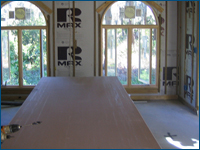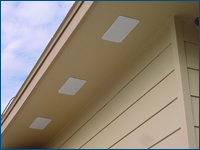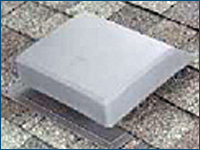
INSULATION
What is R-Value?
The "R" in R-value stands for "resistance"; resistance to the movement in temperature through walls, ceilings and floors in your home or commercial building.
A common differentiating criteria between different types of insulation is the amount of R-value they provide (when correctly installed).
The higher the R-value, the better the insulation.
Another major performance issue with insulation and energy savings is its air sealing capability.
The US Department of Energy estimates that up to 40% or more of your home's energy loss is due to air leakage.
Your insulation choices will affect overall energy performance, monthly energy usage, monthly cost to heat & cool, and the overall comfort of your home
or business. Throughout the years, EHI has carefully chosen products & systems that will better suit our customers when it comes to safety, efficiency and savings.

Fiberglass Insulation
Ever since Owens Corning developed the first fiberglass batt insulation back in 1938, this material has remained the first choice for insulating wood-frame walls. Fiberglass batt insulation is manufactured in different thicknesses and widths, based on common stud, joist and rafter spacing. It's also available unfaced or faced with a variety of materials, including kraft paper, foil-faced kraft paper and plastic. (The faced side of the batt should always be oriented toward the conditioned space, rather that toward the exterior of the building.)
Ever since Owens Corning developed the first fiberglass batt insulation back in 1938, this material has remained the first choice for insulating wood-frame walls. Fiberglass batt insulation is manufactured in different thicknesses and widths, based on common stud, joist and rafter spacing. It's also available unfaced or faced with a variety of materials, including kraft paper, foil-faced kraft paper and plastic. (The faced side of the batt should always be oriented toward the conditioned space, rather that toward the exterior of the building.)

Cellulose Insulation
Is made from recycled papers products and uses up to 80% less energy to manufacture. Cellulose loose-fill insulation is up to 50% more efficient in cold temperatures and settles up to 20% after installation in open attics. To accommodate for this settling there is an "installed" thickness and a "settled" thickness that an experienced installer must follow. Cellulose is treated with Boric Acid to achieve it's fire, pest, and mold resistant rating.
Is made from recycled papers products and uses up to 80% less energy to manufacture. Cellulose loose-fill insulation is up to 50% more efficient in cold temperatures and settles up to 20% after installation in open attics. To accommodate for this settling there is an "installed" thickness and a "settled" thickness that an experienced installer must follow. Cellulose is treated with Boric Acid to achieve it's fire, pest, and mold resistant rating.

Spray Foam Insulation
Our selected brands of spray foam insulation provide you with outstanding energy efficiency. Odorless, urea formaldehyde, inert with no off-gassing - provides a healthier indoor air quality, safe environment. Learn More.
Our selected brands of spray foam insulation provide you with outstanding energy efficiency. Odorless, urea formaldehyde, inert with no off-gassing - provides a healthier indoor air quality, safe environment. Learn More.

Spray Radiant Barrier
A single, thin coat of our spray applied to the underside of your roof deck will block up to 80% of the sun's radiant heat from entering your home through the attic. And in winter, the same barrier will reflect back up to 80% of the heat that tries to escape from your home through the attic. Yet unlike foil substrates, our radiant barrier spray can be applied in a matter of hours instead of days. It goes on evenly, with no gaps or holes. And because it is sprayed on, it can easily be applied to existing roofs.
A single, thin coat of our spray applied to the underside of your roof deck will block up to 80% of the sun's radiant heat from entering your home through the attic. And in winter, the same barrier will reflect back up to 80% of the heat that tries to escape from your home through the attic. Yet unlike foil substrates, our radiant barrier spray can be applied in a matter of hours instead of days. It goes on evenly, with no gaps or holes. And because it is sprayed on, it can easily be applied to existing roofs.

Foil Radiant Barrier
Radiant Barrier is unique form of insulation that is beneficial for any residential home or commercial business. Radiant Barrier is installed in buildings to reduce summer heat gain and winter heat loss, reducing heating and cooling energy use. It is recognized by the EPA as a heat shield that will block out at least 90% of radiant heat. The usual insulation found in most homes today is unable to meet that standard.
Radiant Barrier is unique form of insulation that is beneficial for any residential home or commercial business. Radiant Barrier is installed in buildings to reduce summer heat gain and winter heat loss, reducing heating and cooling energy use. It is recognized by the EPA as a heat shield that will block out at least 90% of radiant heat. The usual insulation found in most homes today is unable to meet that standard.

Insulation Removal
When rodents, water, or even time are introduced to your crawl or attic space, the outcome often results in damage. When this happens, you may need elimination of the rodent or animal infestation; a removal of insulation, vapor barrier, other materials and carcasses, odor control, sanitizing, ventilation, and an install of new insulation & vapor barrier, or other materials. Sometimes it's a home improvement project that warrants removing and replacing the insulation in an attic or crawl space.
When rodents, water, or even time are introduced to your crawl or attic space, the outcome often results in damage. When this happens, you may need elimination of the rodent or animal infestation; a removal of insulation, vapor barrier, other materials and carcasses, odor control, sanitizing, ventilation, and an install of new insulation & vapor barrier, or other materials. Sometimes it's a home improvement project that warrants removing and replacing the insulation in an attic or crawl space.

Drill and Fill
One way we retrofit a house with wall insulation is by drilling a hole in the wall, usually from the outside and spraying in either densely packed borate cellulose insulation or foam insulation. Once we have finished spraying insulation into each section of wall cavity, we plug and patch each hole. (Please note that the homeowner is responsible for supplying matching paint to achieve a seamless finish.)
One way we retrofit a house with wall insulation is by drilling a hole in the wall, usually from the outside and spraying in either densely packed borate cellulose insulation or foam insulation. Once we have finished spraying insulation into each section of wall cavity, we plug and patch each hole. (Please note that the homeowner is responsible for supplying matching paint to achieve a seamless finish.)

Rmax Insulation Sheet
For more than 30 years, Rmax has been creating insulation solutions based on the latest building science. Our full line of high-quality, polyiso-based roof, wall and specialty insulation products for commercial, industrial and residential applications deliver maximum R-values and minimum environmental impact, with efficiency in installation, cost and design.
For more than 30 years, Rmax has been creating insulation solutions based on the latest building science. Our full line of high-quality, polyiso-based roof, wall and specialty insulation products for commercial, industrial and residential applications deliver maximum R-values and minimum environmental impact, with efficiency in installation, cost and design.

Tyvek install
DuPont Tyvek HomeWrap helps protect a home against damaging wind and rain that can penetrate through the exterior cladding. It blocks excess water from entering into walls. The breathable structure of this house wrap allows moisture vapor to pass through to help promote drying in wall systems which can aid in preventing the growth of mold and mildew.
DuPont Tyvek HomeWrap helps protect a home against damaging wind and rain that can penetrate through the exterior cladding. It blocks excess water from entering into walls. The breathable structure of this house wrap allows moisture vapor to pass through to help promote drying in wall systems which can aid in preventing the growth of mold and mildew.
VENTILATION
If you are thinking of adding or installing new insulation with high R–values, you will increase the benefits of the insulation when combining it with proper attic ventilation. Attic ventilation can be done naturally by opening windows or doors, but this is not ideal for most homes. To get the best ventilation, you
will need to consider other methods, such as spot ventilation, or a whole–house ventilation system, which is more cost–effective for larger homes.
If you aren’t sure how to best ventilate your home or office, call EHI and one of our experts will be more than happy to discuss insulation and ventilation strategies with you.

Wind Turbines
A non-electric alternative to ventilation, these vents use the natural force of wind and air pressure to spin and vent out stale attic air. They do it with a series of specially shaped vanes that catch the wind and provide rotary motion. This pulls hot, humid air from the attic. Turbine vents provide a low-cost ventilation alternative in areas where wind speeds of at least 5 mph are typical.
A non-electric alternative to ventilation, these vents use the natural force of wind and air pressure to spin and vent out stale attic air. They do it with a series of specially shaped vanes that catch the wind and provide rotary motion. This pulls hot, humid air from the attic. Turbine vents provide a low-cost ventilation alternative in areas where wind speeds of at least 5 mph are typical.

Solar Powered Fans
Heat and moisture are your attic's worst enemy. Solar Powered Fans are an environmentally friendly way to cool and protect your attic and roof. The solar attic fan will also save you on your cooling costs!
Heat and moisture are your attic's worst enemy. Solar Powered Fans are an environmentally friendly way to cool and protect your attic and roof. The solar attic fan will also save you on your cooling costs!

Soffit Vents
To effectively cool the attic, outside air needs to circulate through it. One solution is to use the natural circulation caused by hot air rising to bring fresh air into the attic through soffit vents under the eaves, then expel the hot air through ridge or gable vents near the peak of the roof.
To effectively cool the attic, outside air needs to circulate through it. One solution is to use the natural circulation caused by hot air rising to bring fresh air into the attic through soffit vents under the eaves, then expel the hot air through ridge or gable vents near the peak of the roof.

Ridge Vents
Years of research prove that a ridge vent with external baffles and an internal weather filter, combined with undereave venting, is the most efficient system you can install. Ridge Vent Benefits: 1.) Works year-round 2.) Provides evenly distributed ventilation along the entire underside of the roof. 3.)Provides a higher volume of airflow per square foot of attic area than any other fixed-vent system. 4.) Design maximizes airflow across the entire underside of roof sheathing.
Years of research prove that a ridge vent with external baffles and an internal weather filter, combined with undereave venting, is the most efficient system you can install. Ridge Vent Benefits: 1.) Works year-round 2.) Provides evenly distributed ventilation along the entire underside of the roof. 3.)Provides a higher volume of airflow per square foot of attic area than any other fixed-vent system. 4.) Design maximizes airflow across the entire underside of roof sheathing.

Gable Vents
Gable vents are placed at the top of the gable on the end of the house. Typically a gable vent would be installed on both ends of the house in hopes of creating a draft through the attic by having both intake and exhaust vents. Unlike other types of vents gable vents are often used for decorative purposes in addition to the function of ventilating the attic. There are a large number of shapes, sizes, materials, and colors available to create the visual appearance desired by the homeowner.
Gable vents are placed at the top of the gable on the end of the house. Typically a gable vent would be installed on both ends of the house in hopes of creating a draft through the attic by having both intake and exhaust vents. Unlike other types of vents gable vents are often used for decorative purposes in addition to the function of ventilating the attic. There are a large number of shapes, sizes, materials, and colors available to create the visual appearance desired by the homeowner.

Foundation Vents
Without proper foundation vents protecting your home, costly damage from damp rot, and possibly termite infestation, can occur. Foundation and exterior vents allow for the natural flow of fresh air under structures that keep moisture levels low and diminish the possibility of severe moisture damage. Proper ventilation in your crawlspace circulates fresh air beneath structures and removes musty, moist air.
Without proper foundation vents protecting your home, costly damage from damp rot, and possibly termite infestation, can occur. Foundation and exterior vents allow for the natural flow of fresh air under structures that keep moisture levels low and diminish the possibility of severe moisture damage. Proper ventilation in your crawlspace circulates fresh air beneath structures and removes musty, moist air.

Airhawks
These covered openings allow air to escape the attic. Several of these vents are usually required to properly ventilate the attic. They should be placed evenly across the roof. Choose from metal or plastic in round, square or slant-back designs.
These covered openings allow air to escape the attic. Several of these vents are usually required to properly ventilate the attic. They should be placed evenly across the roof. Choose from metal or plastic in round, square or slant-back designs.
Ask us
about our other services:
• Home Energy Audits
• Duct replacement
• Duct Sealing
• A/C system sealing
• Door weatherstripping
• Attic tent
• Window sealing
• Window replacement
• Outlet and suitch sealers
• Blower door test
• Attic access ladder install
• Solar Screens
about our other services:
• Home Energy Audits
• Duct replacement
• Duct Sealing
• A/C system sealing
• Door weatherstripping
• Attic tent
• Window sealing
• Window replacement
• Outlet and suitch sealers
• Blower door test
• Attic access ladder install
• Solar Screens

